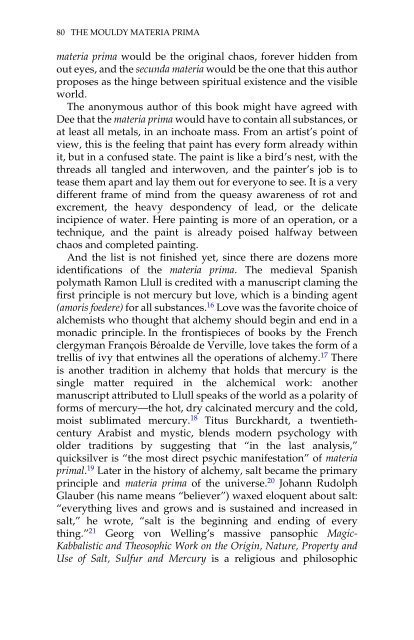What Painting Is: How to Think about Oil Painting ... - Victoria Vesna
What Painting Is: How to Think about Oil Painting ... - Victoria Vesna
What Painting Is: How to Think about Oil Painting ... - Victoria Vesna
Create successful ePaper yourself
Turn your PDF publications into a flip-book with our unique Google optimized e-Paper software.
80 THE MOULDY MATERIA PRIMA<br />
materia prima would be the original chaos, forever hidden from<br />
out eyes, and the secunda materia would be the one that this author<br />
proposes as the hinge between spiritual existence and the visible<br />
world.<br />
The anonymous author of this book might have agreed with<br />
Dee that the materia prima would have <strong>to</strong> contain all substances, or<br />
at least all metals, in an inchoate mass. From an artist’s point of<br />
view, this is the feeling that paint has every form already within<br />
it, but in a confused state. The paint is like a bird’s nest, with the<br />
threads all tangled and interwoven, and the painter’s job is <strong>to</strong><br />
tease them apart and lay them out for everyone <strong>to</strong> see. It is a very<br />
different frame of mind from the queasy awareness of rot and<br />
excrement, the heavy despondency of lead, or the delicate<br />
incipience of water. Here painting is more of an operation, or a<br />
technique, and the paint is already poised halfway between<br />
chaos and completed painting.<br />
And the list is not finished yet, since there are dozens more<br />
identifications of the materia prima. The medieval Spanish<br />
polymath Ramon Llull is credited with a manuscript claming the<br />
first principle is not mercury but love, which is a binding agent<br />
(amoris foedere) for all substances. 16 Love was the favorite choice of<br />
alchemists who thought that alchemy should begin and end in a<br />
monadic principle. In the frontispieces of books by the French<br />
clergyman François Béroalde de Verville, love takes the form of a<br />
trellis of ivy that entwines all the operations of alchemy. 17 There<br />
is another tradition in alchemy that holds that mercury is the<br />
single matter required in the alchemical work: another<br />
manuscript attributed <strong>to</strong> Llull speaks of the world as a polarity of<br />
forms of mercury—the hot, dry calcinated mercury and the cold,<br />
moist sublimated mercury. 18 Titus Burckhardt, a twentiethcentury<br />
Arabist and mystic, blends modern psychology with<br />
older traditions by suggesting that “in the last analysis,”<br />
quicksilver is “the most direct psychic manifestation” of materia<br />
primal. 19 Later in the his<strong>to</strong>ry of alchemy, salt became the primary<br />
principle and materia prima of the universe. 20 Johann Rudolph<br />
Glauber (his name means “believer”) waxed eloquent <strong>about</strong> salt:<br />
“everything lives and grows and is sustained and increased in<br />
salt,” he wrote, “salt is the beginning and ending of every<br />
thing.” 21 Georg von Welling’s massive pansophic Magic-<br />
Kabbalistic and Theosophic Work on the Origin, Nature, Property and<br />
Use of Salt, Sulfur and Mercury is a religious and philosophic


